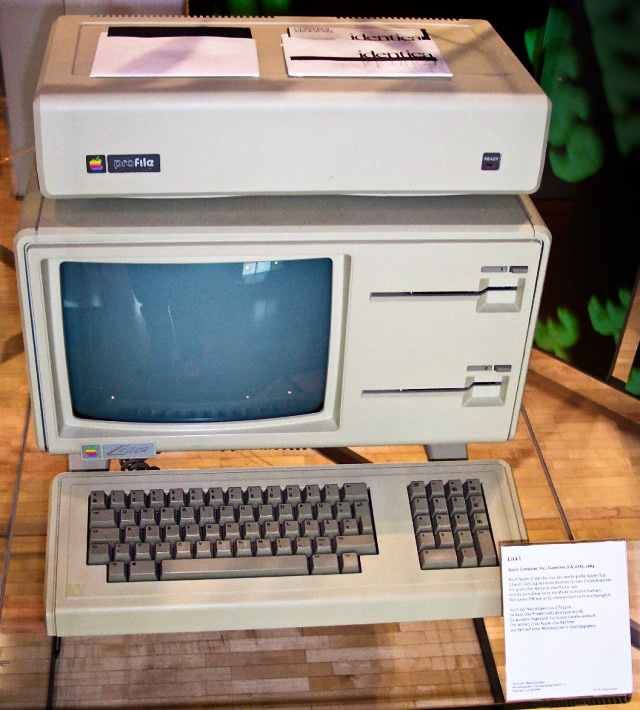YEAR: 1983
PRICE: $9,995, $25,745.96 in 2019
| Lisa, with an Apple ProFile external hard disk sitting atop it, and dual 5.25-inch “Twiggy” floppy drives | |
| Also known as | Locally Integrated Software Architecture |
|---|---|
| Developer | Apple Computer Inc. |
| Manufacturer | Apple Computer Inc. |
| Type | Personal computer |
| Release date | January 19, 1983; 36 years ago |
| Introductory price | US$9,995 (equivalent to $25,143 in 2018) |
| Discontinued | August 1986 |
| Units sold | 10,000[1] |
| Operating system | Lisa OS, Xenix |
| CPU | Motorola 68000 @ 5 MHz |
| Predecessor | Apple II Plus Apple III |
| Successor | Macintosh XL Macintosh |
Lisa is a desktop computer developed by Apple, released on January 19, 1983. It is one of the first personal computers to offer a graphical user interface (GUI) in a machine aimed at individual business users. Development of the Lisa began in 1978 and it underwent many changes during the development period before shipping at US$9,995 with a five-megabyte hard drive. The Lisa was challenged by a high price, insufficient performance, insufficient software library, crash-prone operating system, unreliable Apple FileWare (“Twiggy”) floppy disks, and the immediate release of the cheaper and faster Macintosh — yielding lifelong sales of only 10,000 units in two years.

In 1982, after Steve Jobs was forced out of the Lisa project he appropriated the existing Macintosh project, which Jef Raskin had conceived in 1979 and led to develop a text-based appliance computer. Jobs immediately redefined Macintosh as a cheaper and more usable version of the graphical Lisa. Macintosh was launched in January 1984, quickly surpassing Lisa sales, and assimilating increasing numbers of Lisa staff. Newer Lisa models were introduced that addressed its faults and lowered its price considerably, but the platform failed to achieve favorable sales compared to the much less expensive Mac. The final model, the Lisa 2/10, was modified as the high end of the Macintosh series, the Macintosh XL.
Considered a commercial failure but with technical acclaim, the Lisa introduced a number of advanced features that would not reappear on the Macintosh or the “PC” platform for many years. Among those is an operating system with protected memor and a more document-oriented workflow. The hardware overall is more advanced than the Macintosh, with a hard drive, support for up to 2 megabytes (MB) of random-access memory (RAM), expansion slots, and a larger, higher-resolution display. One notable exception is that the 68000 processor in the Macintosh is clocked at 7.89 megahertz (MHz) and the Lisa’s is 5 MHz.
Read more on WikiWand and also check out our Facebook page.